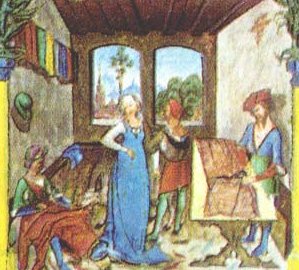Notes on Costume Making
 Clothes are important. They are more than just something we throw on in the morning, they portray an image and they tell people about us and about what we do. This is just as true in re-enactment. We aim to portray medieval people as accurately as possible and we base our recreations around the Stafford household and the Duke of Buckingham in the later part of the 15th century. To be convincing, we must look convincing. No-one is going to believe they have travelled back to the 15th century if they can see trainers and modern watches. It helps us as well, it's far easier to act medieval if you feel it and wearing kit feels different; you move differently and your posture changes, particularly if you're a woman used to wearing jeans!
Clothes are important. They are more than just something we throw on in the morning, they portray an image and they tell people about us and about what we do. This is just as true in re-enactment. We aim to portray medieval people as accurately as possible and we base our recreations around the Stafford household and the Duke of Buckingham in the later part of the 15th century. To be convincing, we must look convincing. No-one is going to believe they have travelled back to the 15th century if they can see trainers and modern watches. It helps us as well, it's far easier to act medieval if you feel it and wearing kit feels different; you move differently and your posture changes, particularly if you're a woman used to wearing jeans!Fashions throughout England often spread very slowly because garments needed to last for years. They needed to be practical and as ideas spread slowly through a low tech country, so did fashions. Most fashions were set by the royal court and spread through the rest of society through imitation of the wealthy; this imitation was hindered by two main factors: money and practicality. Money affected the material that would be used to construct the garment. The second factor would be practicality, if you worked in a field all day you would need simple work clothing rather than imitation high fashion of court. Basic clothing was designed for everyday wear, for every aspect of life as well as every aspect of weather. According to archaeological records, the weather was several degrees colder than today's English climate. This fact, compared with our less structured society, means that they dressed in different ways than we are used to in modern life. Since most of our events are in the hotter summer months, this can mean personal comfort and authenticity often clash, as medieval clothing was frequently made up of numerous layers of various heavyweight fabrics. When you come to choose your clothes, remember authenticity and comfort.
This guide attempts to show you how to design and make medieval clothing for you to wear at one of our historical re-enactments. The kit discussed within these pages is basic everyday wear, things that any one and everyone can wear. The styles I will be covering are the accepted basics for the group. This doesn't mean if you have something not covered you can't wear it, but please ask an older member of the group to confirm that your items are correct for the period that we are portraying. Obviously some roles, for instance officers, priests, nobility etc., have different or more expensive kit and I would recommend discussing those kit needs with the current authenticity officer within the group.
As you develop within our group and find a niche for yourself within our medieval world, you may require various levels of kit for different aspects of our groups' performances that encompass different social levels and settings; this will be your own choice. Kit standards have changed drastically since I became a re-enactor, I advise people to make the most authentic kit possible for themselves. Members of Buckingham's Retinue follow these guidelines, as do many of the other groups we work with. As you wear your medieval clothing you will be better at determining your preferences in the clothing styles and you will be able to design and style your own clothes to fit you better.
